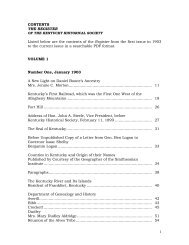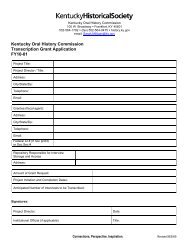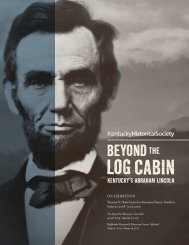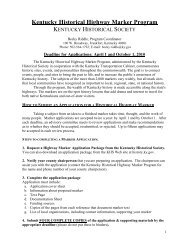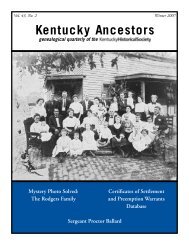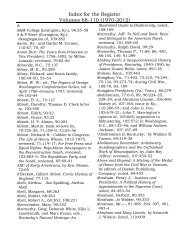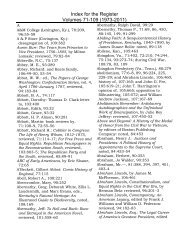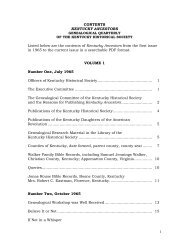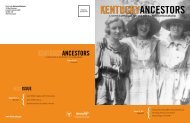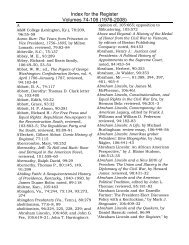Kentucky Ancestors, Volume 46, Number 3 - Kentucky Historical ...
Kentucky Ancestors, Volume 46, Number 3 - Kentucky Historical ...
Kentucky Ancestors, Volume 46, Number 3 - Kentucky Historical ...
Create successful ePaper yourself
Turn your PDF publications into a flip-book with our unique Google optimized e-Paper software.
20 July 2011 ~ Wednesday<br />
“Germanna in the Hinterland” Event<br />
Boone County, <strong>Kentucky</strong><br />
What is Germanna?<br />
Germanna was a German settlement in the colony of<br />
Virginia, settled in two waves, first in 1714 and then<br />
in 1717. The name Germanna, selected by Governor<br />
Alexander Spotswood, reflected both the German<br />
immigrants who sailed across the Atlantic to Virginia<br />
and the British queen, Anne, who was in power at the<br />
time of the first settlement.<br />
The Germanna colonies consisted primarily of the<br />
First Colony of forty-two persons from the Siegerland<br />
area in Germany brought to Virginia to work for<br />
Spotswood in 1714, and the Second Colony of twenty<br />
families from the Palatinate and Baden-Wuerttemberg<br />
area of Germany brought in 1717, but also included<br />
other German families who joined the first two colonies<br />
at later dates. By religion they were predominantly<br />
Lutheran.<br />
In 1740, a church was built by the Germanna<br />
immigrants of 1717 (the second Germanna Colony).<br />
They had moved to the Madison area from the<br />
Germanna settlement (located where Virginia Route 3<br />
crosses the Rapidan River) in about 1726 and took out<br />
land patents. They had finally won freedom from their<br />
indenture to Gov. Spotswood, and it was in this area<br />
that they began building lives for themselves and their<br />
children.<br />
The German Lutheran Church (Hebron Lutheran<br />
Church today) is located just north of Madison,<br />
Virginia, and is the oldest Lutheran church in<br />
continuous use by Lutherans in the United States.<br />
Leaving Virginia for the Hinterland [<strong>Kentucky</strong>]<br />
~ October 1805<br />
The below entry was transcribed and translated from<br />
the original German Church records and is published<br />
on page 36 of the book, Hebron Communion Lists of the<br />
German Lutheran Church in Culpeper/Madison counties,<br />
Virginia (1775 to 1882), by Andreas Mielke and John<br />
Blankenbaker; 2003, being the second and enlarged<br />
edition.<br />
152 | <strong>Kentucky</strong> <strong>Ancestors</strong><br />
3 Oct 1805<br />
All persons about to move to the hinterland<br />
[<strong>Kentucky</strong>]<br />
Johann Willheit wife Elisabeth<br />
Georg Rausch wife Elisabeth<br />
Polly Zimmerman<br />
Johann Rausch wife Nancy<br />
Friederich Zimmermann wife Rosina<br />
Abraham Crigler wife Lyddia<br />
Ephraim Tanner wife Susanna<br />
Johann Hauss wife Milly<br />
Jacob Tanner<br />
Elisabeth Hofmann<br />
Margret Carpenter<br />
This Germanna group left Madison County,<br />
Virginia, and traveled to Boone County, <strong>Kentucky</strong>,<br />
by way of wagon, possibly through the Cumberland<br />
Gap. The group was said to consist of George Rouse,<br />
Elizabeth Rouse, John House, Milly House, Frederick<br />
Zimmerman, Rose Zimmerman, Ephraim Tanner,<br />
Susanna Tanner, John Rouse, Nancy Rouse, and<br />
Elizabeth Hoffman. They are said to have arrived in<br />
Boone County, <strong>Kentucky</strong>, on 25 November 1805. The<br />
greater part of northern <strong>Kentucky</strong> was little more than a<br />
wilderness when they settled here in Boone County. At<br />
this time, Burlington, the county seat of Boone County,<br />
consisted of a few log houses, a log court house, and<br />
log jail. The town of Florence did not exist at that date.<br />
Across the Ohio River, Cincinnati consisted of two brick<br />
houses and two frame houses.<br />
Here in Boone County, <strong>Kentucky</strong>, they founded the<br />
Hopeful Lutheran Church. The first worship services<br />
were held in 1805, with the first congregation being<br />
organized on Epiphany Day, January 6, 1806. Other<br />
German families from Virginia followed. Hopeful<br />
Evangelical Lutheran Church is the oldest Lutheran<br />
Church west of the Allegheny Mountains.<br />
Please join us on 20 July 2011 for a day in<br />
celebration of our Germanna heritage and the migration<br />
of our ancestors to <strong>Kentucky</strong>. The date for this event





